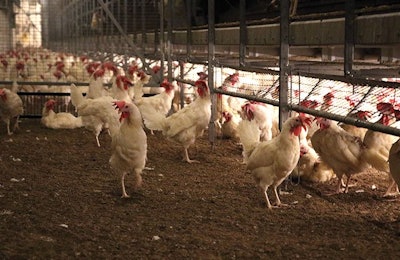
Compared with cage housing, cage-free houses have reduced air quality with higher dust and ammonia levels. Fine dust particles can travel into the lungs of animals, causing or exacerbating lung and heart diseases.
Dust particles can also transport odors and harmful gases as well as microorganisms, including pathogens. There is also concern about the impact of higher dust levels on reduced egg production and poultry health in cage-free houses attributed to poorer air quality than in caged houses.
Air quality is poorer during winter when ventilation rates may be reduced to conserve energy. The spraying of water and/or diluted acid solutions may reduce dust and ammonia levels but causes undesirable chilling and dust caking on the eggs.
There is a need to improve air quality in cage-free houses. Hence, principal investigators Dr. Sanjay Shah, Dr. Kenneth Anderson and Dr. Lingjuan Wang-Li, at North Carolina State University, were awarded a research grant by USPOULTRY and the USPOULTRY Foundation to evaluate a technology that can reduce these environmental issues. Their work assesses electrostatic precipitation (ESP) effectiveness in cage-free layer houses for reducing dust levels.
Electrostatic charge
In ESP, air is charged using high voltage, which causes the dust particles to attach to one another and settle on the floor or on grounded surfaces, reducing dust and microbial concentrations from the air.
Previous research using ESP was performed by passively charging the air with electrodes hung from the ceiling of the barn. However, this novel ESP-based recirculating air cleaner pulls in barn air, and dust particles acquire charge and attach to the duct surface. The attached dust will be knocked off the duct walls using a rapper and deposited in a dust collection bag at the bottom of the duct, preventing resuspension of the dust into the house by workers and birds.
The charging occurs inside the duct, improving the effectiveness of dust collection over systems suspended from ceilings. The ESP air cleaner will be tested in a commercial cage-free barn for its ability to improve air quality.

Dust often gathers on the air inlets of a cage-free house. The ESP air cleaner would help minimize this issue. (Deven King)
Building a working prototype
This research project will design and fabricate a full-scale recirculating ESP unit. The objective will be to evaluate the removal efficiency of the ESP in the cage-free layer house for particulate matter, ammonia and airborne bacteria and fungi.
While optimizing the ESP system’s zone of influence, the investigators expect that the air cleaner will trap a substantial fraction of the dust passing through it, leading to proportionate removal of ammonia and microorganisms from the air stream. The air cleaner could substantially improve air quality by reducing dust, microbial and ammonia levels within its zone of influence.
If this technology can effectively remove particulate matter, ammonia and bacteria from the air and can be adaptable to the broiler and turkey industries as well, the industry will benefit tremendously.
Potential benefits
Cage-free layers will experience improved bird performance and welfare due to better indoor air quality. ESP can improve conditions for poultry workers and reduce emissions of air pollutants, including odor.
In warm weather, where high ventilation rates provide adequate particulate dilution, the air cleaner’s fan could be used to provide additional air movement over the nest boxes where air speeds are much lower than over the litter.
“Improving indoor air quality is a win-win proposition, since it can enhance bird performance, health and welfare, benefit the workers, and could even reduce harmful air emissions,” the principal investigators said.

















